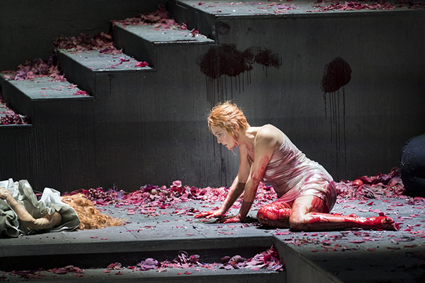| Opera Reviews | 26 April 2024 |
A new Salome of unflinching intensityby Moore Parker |
|
| Strauss, R: Salome Theater an der Wien 20 January 2020 |
|

Marlis Petersen (Salome)
|
|
|
In its unusually intimate setting and orchestral adaptation (Eberhard Kloke), the Theater an der Wien’s new Salome guaranteed for a riveting and challenging evening of opera - but one with unequivocal demands upon both audience and cast. Here, Strauss’ one-acter began minutes before the first bars of music, revealing grey steeply-stepped panels surrounding a central circular cistern - its mirrored lid held by heavy ascending chains, and flanked by stern-faced guards brandishing heavy automatic rifles. The rear revealed the Tetrarch’s quarters with slick “his” and “her” thrones setting (design, Julius Theodor Semmelmann) the scene effectively - if anonymously - in some contemporary dictatorship. First and foremost, the production is underscored by unflinching intensity and a cast of compellingly-drawn characters - including two extras, who appear in the form of director Nikolaus Habjan’s signature trademark - as life-sized puppets. Salome is accorded a half-torso alter ego - a young Bette Davis, “Baby Jane”-like creation - with expressively pleading eyes, red gaping mouth, and flowing golden locks. Johan Reuter (Jochanaan) is costumed and coloured from head-to-foot to blend with the sets, interacting almost as a ghost with the other protagonists as well as his puppet; a starved and tortured life-sized figure, chained, and with a bulbous-eyed stare transfixed somewhere beyond reality, hanging pathetically within the cistern walls. Both creations are unquestionably potent - visually, and as multi-layered sub strata (be it in the defenceless fate of the Prophet or the schizophrenic impulses of the title character), but they come at a cost; in part distraction, and in part, through remaining unresolved - both scenically and logically within the action. Marlis Petersen’s Salome would amount to a tour-de-force, even without her additional task as puppeteer - a creation quite extraordinary in energy, athleticism, vocal stamina, and range of expression. Irrespective of staging demands, her soft-grained soprano rode the composer’s gruelling lines with seeming ease - while periodic respite from the puppet in many scenes strongly testified that this fine artist’s candid ability to express and communicate ultimately rendered the doll as superfluous, if not disadvantageous. The finale, in which an unrelenting flow of “blood” from the Baptist’s severed head drenched her lightweight dress and naked limbs, somehow capped a remarkable physical and artistic achievement which earned frenetic appreciation at the curtain. The production’s concept placed automatic emphasis upon the vocal element of Johan Reuter’s Jochanaan, with the singer at times disappearing into the shadows and subservient to his dramatically-outlined puppet. Reuter rose well to the slightly thankless task with imposingly stentorian tone and (in keeping with all leads) exceptional clarity of diction, and pointed word. John Dazak’s Herodes enjoyed particular highlighting through Habjan’s interesting concept, which went far beyond traditional interaction with his spouse to new realms of intimacy with both the animate and inanimate Salome - culminating in fevered copulation with the puppet in an aggressive rape-like act enforced by Salome as her dance scene climaxed (choreography, Esther Balfe). The entire cast was superbly made-up and costumed (Cedric Mpaka), with Strawberry Blond coiffes a distinct theme among the women - not least Herodias’ haystack page-boy which augmented Michaela Schuster’s dramatic poses and wonderfully expressive facial gestures. Her appetite for oysters and the withholding of her spouse’s ring as she takes his throne at the close were nice touches, as was Herodes’ dead white peacock which remained on show throughout the performance. On this evening the scheduled Narraboth was forced to cancel due to illness, but a team solution was successfully found through a combination of forces with Paul Schweinester (Erste Jude), who sight-read the part from the footlights, and Nikolas Habjan who acted and mimed the part. The remaining protagonists were essentially well cast if somewhat hackneyed in action, while the entire framework was enhanced by Strauss’ original scoring was re-worked for this new version - compacting the original 106 to 59 players by the German composer, Eberhard Kloke. The adaption involved additions, which included the Heckelphone (bass oboe), Wagner Tuba, and an extended timpani section. The ORF Radio-Symphonieorchester Wien filled the Theater an der Wien’s orchestra pit and auditorium to capacity - with opulent dynamics and, on occasions, unfamiliar colours which effectively mirrored and augmented the elemental and brutal elements in the tale. Leo Hussein’s reading leaned toward the brash and bold, as if oddly compensating for - rather than utilising - this Salome’s unique opportunity and setting in its first showing. Herodes’ final utterance, “Man tötet dieses Weib” was awaited with unfulfilled expectation. A simple black out concluded.
|
|
| Text ©
Moore Parker Photo © Werner Kmetitsch |
|







